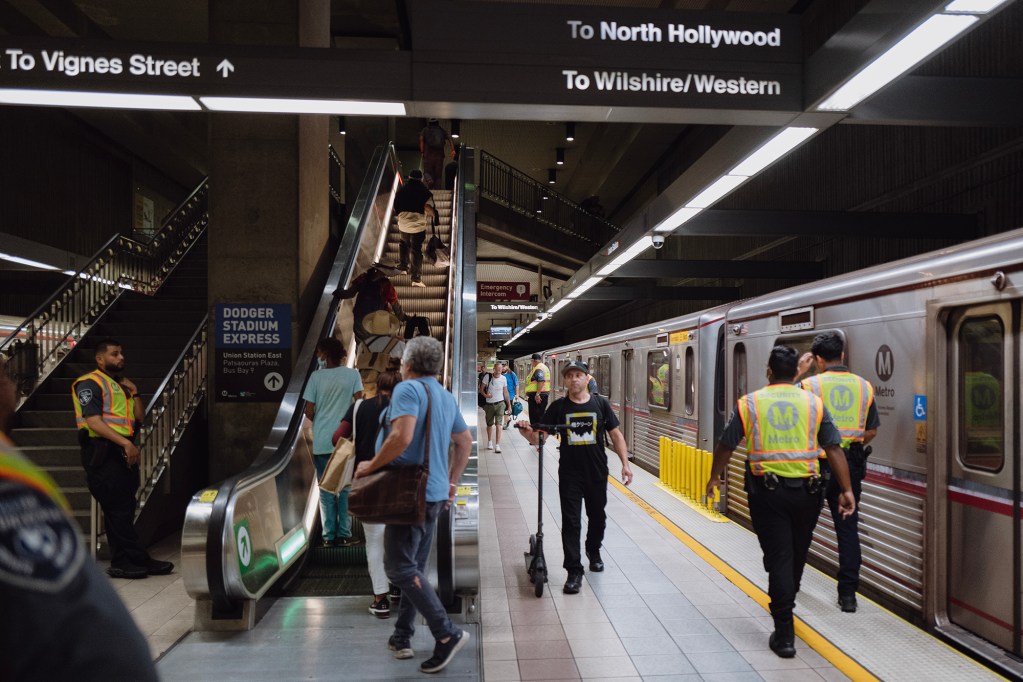Los Angeles Mayor Karen Bass accepted the Olympic flag in Paris last month, formally marking the beginning of the runup to the 2028 Games in LA. With that handoff comes the ultimate civic challenge: Will Los Angeles maximize the opportunities that the Olympics offer?
One important place to look is transportation. Planners have boasted about creating a “car-free” Olympics in 2028, which sounds like a tall order for a city notoriously dependent on its freeways.
That promise isn’t necessarily too firm, either. A spokesperson clarified this week that “most LA28 venues will not require spectators to drive in their cars and will be accessible by public transportation and Games-specific transportation systems.”
That’s not quite “car-free,” but it’s still an ambitious goal in the land of the car.
Even if that’s achievable, the larger question for many city leaders is whether the improvements needed for the Olympics will carry over once the Games end.
It’s possible that they won’t. Olympic planners have, for instance, arranged to borrow 2,700 buses to shuttle athletes and ticket holders to events as part of what Metro, the regional transportation authority, calls “games enhanced transit.” Those buses will help hold down car traffic, but they won’t do anything lasting for the region; they’ll be returned to their lenders, and the “enhanced transit” that they provide will go back to normal once the Games are over — which is to say, traffic will resume.
Same applies for other temporary measures such as reserving some streets and freeway lanes for Olympic-related shuttles. As with the borrowed buses, those fixes may alleviate traffic for a few weeks, but they could go away as soon as the torch passes onto the next city.
Some long-term projects, meanwhile, are being highlighted by the approaching Games, but really aren’t connected to them. For example, Metro is expanding, with new rail and bus lines extending west and connecting the San Fernando Valley to the Westside. If those projects can be completed in time for the Games, they will help make the region more navigable for visitors, but they were contemplated before the Games and are not directly tied to that event.
What, then, do the Games offer Los Angeles in terms of transportation money or benefits?
City Councilwoman Katy Yaroslavsky, who sits on the region’s Metro board, stressed the importance of the city not just relying on short-term arrangements to handle the influx of visitors during the Games. It’s crucial, she said, to “use the Olympics to accelerate a lot of the work that we know we need to do anyway, around ‘first-mile, last-mile,’ around connectivity, around bus and bike lanes.”
Those improvements, she added, will help visitors to the Games but will remain afterward, relieving Metro of some of the obligation to pay for them while also providing long-term improvements for residents.
Combined, she said, those projects exceed $200 million, so securing outside support for them as a part of the Olympic effort would be a significant benefit to local taxpayers.
Other improvements on the table include modernizing stations and improving streets and sidewalks that Olympic visitors will use to get to venues. The Metro Center hub at 7th Street, for instance, is surrounded by sidewalks in need of repair; they might get cleaned up, as could the areas around other stations and junction points that are part of the “mobility hub network” that the Olympic effort is creating to shuttle visitors to venues.
Those projects do not represent an overhaul of the regional transit system, and that’s no accident. In fact, the transit situation underscores a paradox of the LA Games: The city was chosen in part because it already has the stadia and other amenities needed to host an Olympics, but because of that, it stands to gain less than some cities in return for putting on the two-week extravaganza.
By contrast, when Atlanta hosted the 1996 Summer Olympics, it built a major aquatic center on the campus of Georgia Tech and an Olympic stadium that went on to become the home of the Atlanta Braves and then Georgia State University’s football team.
Los Angeles does not need much of that. It already has the Los Angeles Memorial Coliseum (home of the 1932 and 1984 Games), which will be the scene for the opening and closing ceremonies and will become the first facility ever to perform that role three times. Meanwhile, the region includes the Rose Bowl and SoFi Stadium, as well as a plethora of indoor arenas for basketball, gymnastics and other sports.
Something similar is true in transportation. Since Los Angeles already has or is building much of the transportation needed to host the Games, local governments can’t expect the Olympics to pay for major capital investments that are already underway.
That’s why Yaroslavsky’s approach makes sense: Let the Games pay for improvements that would help the Games be a better experience — if not car-free, at least mostly car-free — but that also will outlive the Olympics themselves, freeing local dollars to pay for other parts of the growing system.
The Olympics are a moment of international attention and recognition, but they also are an important opportunity. When it comes to transportation, they offer Los Angeles the chance to do things it might otherwise struggle to accomplish. This opportunity cannot be wasted.
As Yaroslavsky rightly noted, “The Olympics will be a failure if we don’t leverage it to go get what we need.”

